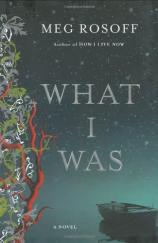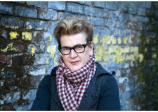What I Was
Review
What I Was
Publishers and the general reading public are finally getting wise to a truth that those of us who review young adult fiction have known for a long time: some of the best, most profound novels in recent years have been published in the "young adult" category.
Meg Rosoff is one of those novelists who has managed to transcend categorization as a writer solely for young people, and now her newest book, WHAT I WAS, is being published and marketed for an adult audience. Although it does not differ markedly in style or maturity from her earlier work, such as her award-winning post-apocalyptic novel HOW I LIVE NOW, WHAT I WAS should reach a deservedly larger audience thanks to Rosoff's publisher's decision to broaden her readership.
WHAT I WAS begins in the not-too-distant future, as our narrator (who remains nameless for most of the book), now an aged man on the brink of 100, rows along the coast of England with his young godson. Desperately trying to find and identify the landmarks of his youth, the narrator casts his mind back to the time he spent in this area when he was a student at St. Oswald's boarding school in the years after World War II.
As a boy, the narrator was a disastrous student. Asked to leave a series of boarding schools due to "the deplorable nature of my behavior and grades," the narrator's main failing is his inability to successfully navigate the social structures and power struggles that characterize boys' schools such as St. Oswald's. Thanks to the brutal bullying of his roommates and the benign neglect of the schools' authority figures, the narrator, thoroughly miserable, uses every opportunity to escape from the confines of St. Oswald's. It is on one such escape that he makes a discovery that will change his life forever.
The narrator discovers a remote cottage, set apart from the mainland, as it is only reachable during low tide. The cottage is set apart figuratively, too, as it seems to belong to an era of history long before the conflicts and political struggles of the 20th century. The narrator also meets --- and becomes instantly enamored of --- the cabin's sole occupant, a boy of about his own age named Finn. Readers will find themselves asking whether the narrator is obsessed with Finn because he loves him or because he wants to be him and all he represents, set as he is, far apart from the daily torments of St. Oswald's and society in general.
There is a lot to digest in Rosoff's latest novel. Questions of sexuality, friendship, identity and love are raised, as is the question of fate. Most intriguing is its exploration of history. The author intentionally posits Finn as leading a pre-modern existence, a simple way of life analogous to the alluring Dark Ages the narrator studies in school. Contrasting this with the power-hungry, social-climbing, rule-abiding 20th century in which the narrator reluctantly finds himself, Rosoff constructs a sort of allegory of history embodied by two very different young people.
WHAT I WAS is not perfect --- an implicit warning about global warming seems out of place, as does the narrator's callous indifference to the fate of one obnoxious classmate --- but it is provocative. Using a dreamy, elegiac tone that captures an old man's recollection of his youth, Rosoff nevertheless evokes youth's indiscretions and obsessions every bit as capably as she has done in her more typical "young adult" titles. Mature teens will still find much to ponder here. More importantly, adults who see this novel in the general fiction shelves may be inspired to pick up Rosoff's other work and discover what those of us who enjoy young adult literature have known all along.
Reviewed by Norah Piehl on January 24, 2011
What I Was
- Publication Date: January 24, 2008
- Genres: Fiction
- Hardcover: 209 pages
- Publisher: Viking Adult
- ISBN-10: 0670018449
- ISBN-13: 9780670018444





